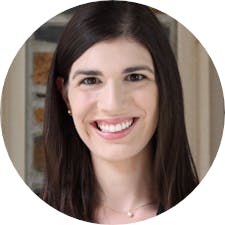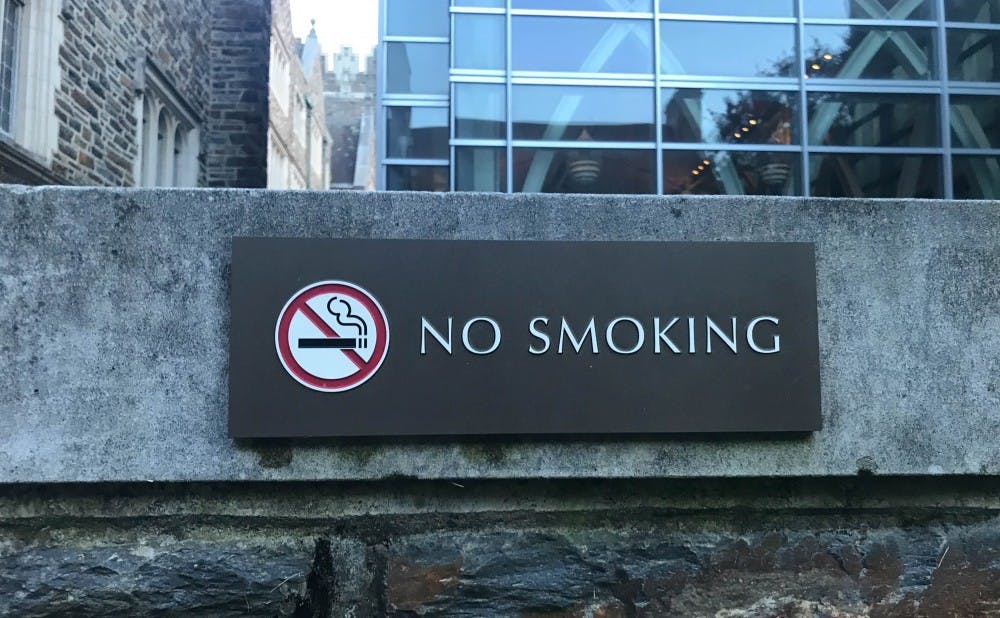Want to smoke? Not for much longer on Duke's campus.
President Vincent Price announced in April that Duke will become a smoke-free campus starting July 1, 2020. This ban covers combustible forms of tobacco, like cigarettes, cigars and hookahs—but does not apply to e-cigarettes, chewing tobacco or therapeutic products containing nicotine.
Research for this policy had already been in the works for quite some time—and has found that a ban alone will not significantly change the health of the community.
James Davis, assistant professor of medicine and medical director of the Duke Center for Smoking Cessation, wrote in an email that he and other members of the program had spent roughly a year researching other campuses that already underwent the smoke-free transition. He explained that they found a “real change in the health of a community" on a smoke-free campus when accompanied by “high quality” treatment and a policy education that was made accessible to all students, faculty and staff.
“What we found is that the policy itself is really the tip of the iceberg,” Davis wrote. “The real impact on campus has to do with an implementation of effective, affordable treatment and broad education on the harms of tobacco.”
Equipped with free, “world-class" treatment and an educational mission, Davis said that Duke will be doing just that.
Junior Kushal Kadakia, former executive vice president of Duke Student Government, described the University's endorsement of the policy as a “major public health victory.” Kadakia has acted as a liaison between the student body and the smoke-free initiative, advocating for the policy change at Graduate and Professional Student Council and DSG meetings.
He noted that such an education is of particular importance to Duke students because two percent of them matriculate as regular smokers and roughly 11 percent graduate as smokers. Duke becoming a smoke-free campus will foster a “healthier campus with a broader culture of wellness,” Kadakia added.
“By having the policy in place, no longer selling such things on campus, having treatment available, we'll see those rates cut in half based on the literature,” Kadakia said.
But, why wait two years to implement the policy? Davis indicated in an email that institutions that enacted the policy within a year noticed that the transition was “too fast” to “provide sufficient education and treatment up front.” Campuses with two to three year windows yielded better results.
Davis added that he and his team collected survey data and talked to “multiple groups and individuals” to gauge what Duke community members would value most in a smoking policy. Davis emphasized that the implemented changes “strongly reflect the views of students, faculty and employees on campus.”
“There is no enforcement until 2020, when the policy will go into effect,” Kadakia said. “In the transition period, there is a lot of stuff we will be doing…with different student groups on campus to make sure we are communicating the changes.”
Kadakia highlighted some of the primary means the program plans to communicate the changes to the student body, which include a collaboration with admissions to relay the smoke-free policy to incoming students, the use of student programming and enhancing AlcoholEdu training with more information on tobacco smoking.
"I think it's really important to educate people and promote the health education and health literacy,” Kadakia said.
The smoke-free policy will be enforced through a “community-based system,” Kadakia said. Some people will have great difficulty attempting to stop smoking, he noted, so it is "really important” that the policy does not target these people, but rather provides them with access to the resources they need.
According to Kadakia, it is important for the Duke community to understand why only combustible products–not non-combustible tobacco products–are prohibited by the new policy.
Combustible forms contain carcinogens that increase the risk of cancer, heart disease and chronic obstructive pulmonary disease. Non-combustible forms–like e-cigarettes and chewing tobacco–“have just as much nicotine as cigarettes but far lower levels of carcinogens and other toxins,” Kadakia wrote in an email.
Additionally, as not all smokers are able to quit smoking, both Kadakia and Davis indicated that not banning noncombustible forms would be necessary to provide a means of therapy and to prevent marginalization on campus.
In fact, Davis noted that the majority of the Duke community reflected that message “loud and clear.”
“[Duke students, faculty and staff] are only interested in implementing a policy if we have a decent strategy for managing smokers with high level addiction who are going to have a lot of trouble quitting,” Davis wrote. “If a policy like this went through they wanted to see really effective treatment made available to everyone.”
Get The Chronicle straight to your inbox
Sign up for our weekly newsletter. Cancel at any time.
However, “good, long-term data” on e-cigarettes does not exist, Davis added. Although e-cigarettes are not as harmful as cigarettes, Davis explained that the policy’s educational aspect is an attempt to provide Duke community members with knowledge on noncombustible forms of tobacco’s “relative harm.”
“I am personally concerned about the growing use of e-cigarettes among students,” Davis wrote. “Part of this initiative will be an education and outreach campaign to help students understand the dangers of e-cigarettes and specifically the dangers of nicotine addiction.”

Stefanie Pousoulides is The Chronicle's Investigations Editor. A senior from Akron, Ohio, Stefanie is double majoring in political science and international comparative studies and serves as a Senior Editor of The Muse Magazine, Duke's feminist magazine. She is also a former co-Editor-in-Chief of The Muse Magazine and a former reporting intern at PolitiFact in Washington, D.C.

